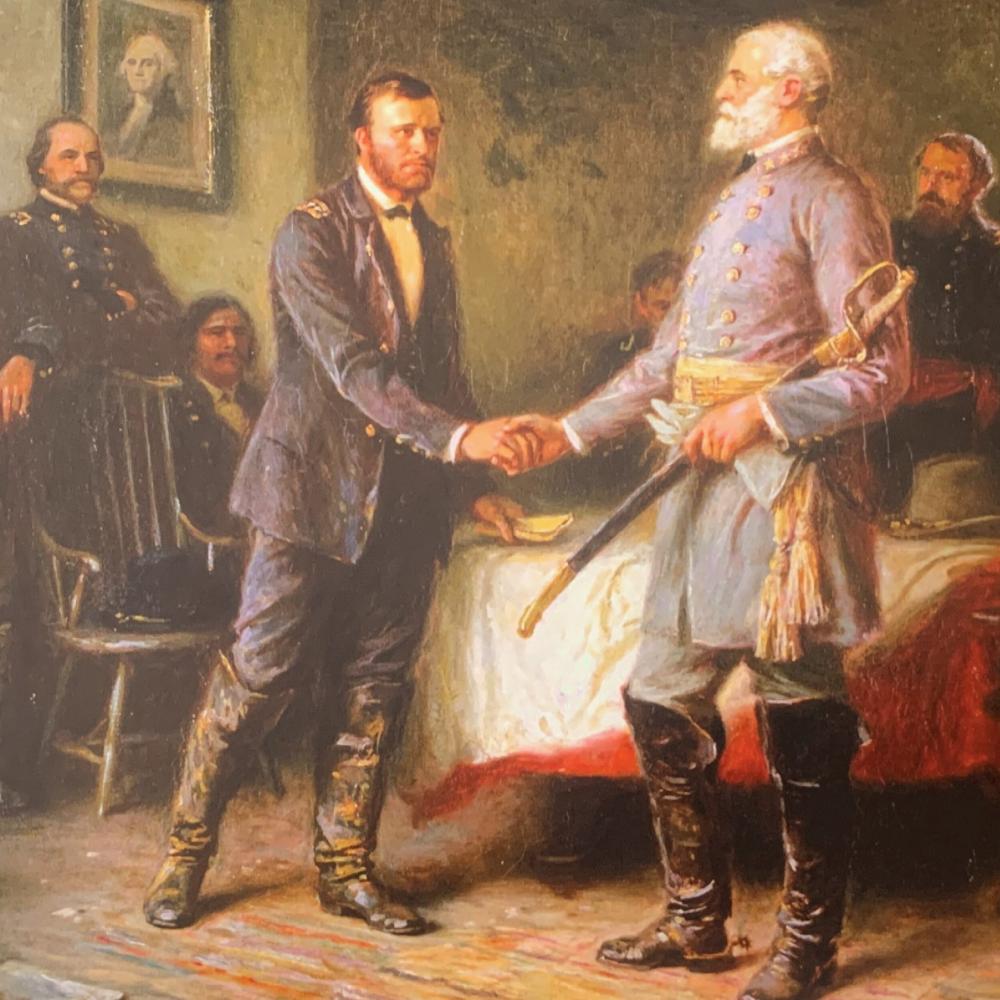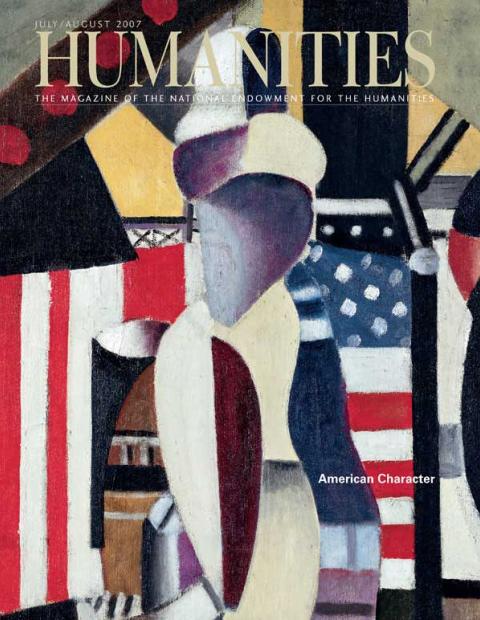On May 5, 1864, the day dawned beautifully over the Rapidan in Virginia. It would not remain so. Over the next two days Robert E. Lee’s Army of Northern Virginia faced Ulysses S. Grant’s Army of the Potomac. “The woods were set on fire by the bursting shell, and the conflagration raged. The wounded . . . were either suffocated or burned to death,” wrote Grant. By the time the battle finished, each general had lost 20 percent of his army.
The encounter, which became known as the Battle of the Wilderness, was the first time the generals fought against each other in the Civil War. But it was not the first time that their lives had intersected, nor would it be the last. “Lee and Grant,” a new NEH-funded traveling exhibition opening at the Virginia Historical Society on October 17, profiles the two men and attempts to reclaim them from the mystique that has distorted their history and legacy.
According to the show’s curators—William Rasmussen of the Virginia Historical Society and Robert Tilton, chairman of the English department at the University of Connecticut, Storrs—historical assessments of Lee and Grant have been influenced by parochialism and contemporary politics. “Both men have been regionalized; one was a hero and the other was a villain. At the same time, Lee was given too much adulation and Grant too little—Grant’s reputation just plummeted. People have not been getting a true picture of either,” says Rasmussen.
In the exhibition and the accompanying catalog, the curators use the generals’ words and those of their contemporaries to reintroduce the men. The commonalities between the two men are striking. They both owned slaves, both were against secession, and both believed that politicians let things get out of hand. “It’s amazing to see them saying essentially the same thing about slavery, secession, and avoiding the war,” says Rasmussen.
For Robert E. Lee, the elder of the two by sixteen years, honor was everything. His father’s accomplishments and failures were both sources of pride and shame. Henry Lee III was a Revolutionary War hero and a governor of Virginia, but his financial failings landed him in debtors’ prison. When Lee was a child, his father exiled himself to the West Indies following a brutal attack by a Baltimore mob in 1812.
Grant’s early life on the Ohio frontier is a startling contrast. His father, Jesse Grant, was a tanner by trade. Adverse to the family business, Grant spent much of his time working the family’s farmland and developing his skills as a horseman.
The lack of family money to pay for a university education resulted in both men attending West Point. The army’s traditions of honor suited Lee, who graduated second in his class in 1829. Lee “never ‘ran the sentinel post,’ did not go off the limits to the ‘Benny Havens’ of his day, or put ‘dummies’ in his bed to deceive the officer in charge as he made his inspection after taps,” according to his nephew Fitzhugh Lee.
Grant, on the other hand, chafed at West Point’s rigors, while excelling in math and horsemanship. When he graduated in 1843, he was 21 out of a class of 39, his demerits sinking his standing. “A military life had no charms for me, and I had not the faintest idea of staying in the army even if I should be graduated, which I did not expect,” wrote Grant.
For men of their generation, the Mexican War became the first place to test their mettle as soldiers. “To Grant, the Mexican War taught the importance of leadership, morale, and a well-fed and well-clothed army. For Lee, by contrast, the Mexican War offered an immersion in strategy and field operations under varied conditions,” says New-York Historical Society curator Kathleen Hulser, who worked on the exhibition’s development.
Grant’s schooling in leadership came from his mentor General Zachary Taylor. “General Taylor was not an officer to trouble the administration much with his demands, but was inclined to do the best he could with the means given him . . . ,” noted Grant. “No soldier could face either danger or responsibility more calmly than he.”
During the war, Lee served on General Winfield Scott’s staff. He spent much of his time scouting territory, and he saw combat at the Battle of Cerro Gordo, where his skills as an engineer helped secure American victory. Following the battle, where he was brevetted major, Lee wrote to his son. “I thought of you, my dear Custis, when the musket balls and grape were whistling over my head in a perfect shower . . . You have no idea what a horrible sight a battlefield is.”
Following the Mexican War, Grant resigned his commission and tried his hand at farming and business. But after the fall of Fort Sumter, he once again returned to the army on the side of the Union. “There are but two parties now, traitors and patriots, and I want hereafter to be ranked with the latter,” Grant wrote to his father.
Lee, now a colonel in the U.S. Army, faced a harder decision: whether to assume command of the Federal army or back Virginia’s secession efforts, thereby ending his career. He wrote to his sister Ann: “With all my devotion to the Union and the feeling of loyalty and duty of an American citizen, I have not been able to make up my mind to raise my hand against my relatives, my children, my home.”
Lee and Grant wouldn’t face each other on the battlefield until three years into the Civil War. That first battle was deemed a draw, but Grant kept pushing. The two armies battled their way through Virginia to Spotsylvania Courthouse and Cold Harbor. “We must destroy this army of Grant’s before he gets to the James River,” said Lee. “If he gets there, it will become a siege, and then it will be a mere question of time.”
In mid-June 1864, the Army of the Potomac crossed the James River hoping to capture Petersburg, the supply center for the Confederacy. Unable to capture Petersburg, Grant lay siege to it and Richmond.
The following April, Lee surrendered under generous terms offered by Grant, effectively ending a war that neither had wanted. Their meeting at Appomattox to conclude the surrender was preceded by an exchange of letters that demonstrated both men’s graciousness. It also marked the first time they had seen each other since a chance encounter during the Mexican War.
Grant used his presidency to ensure that sacrifices made during the Civil War were not in vain. “How many other presidents put the country back together after a bitter civil war, and pioneered the earliest efforts to bring African Americans into full citizenship?” asks Hulser. Grant’s deeds were certainly lauded during his own lifetime; when he toured the world after his presidency, he was hailed as the savior of the American experiment in democracy.
After the war, Lee became president of Washington College (now Washington and Lee University). He also encouraged his compatriots to move beyond the war. “All should unite in honest efforts to obliterate the effects of war, and to restore the blessings of peace,” wrote Lee to former Virginia governor John Letcher in August 1865.
Lee started to write his own memoirs, but he became discouraged because many of his wartime records had been destroyed, and he had difficulty finding what was needed to verify his story. Grant, however, had more success. His memoirs, edited and published by Mark Twain, netted a record $200,000 in royalties.
In assessing Lee and Grant, Rasmussen and Tilton conclude in the catalog that, “Perhaps the most important thing to remember about them is that their accomplishments and shortcomings are tied to the values of the regions that bred them during the periods in which they lived.”


